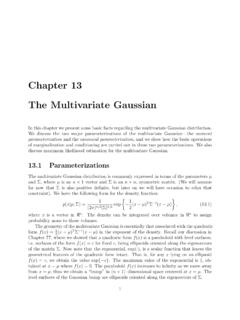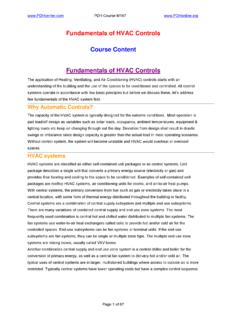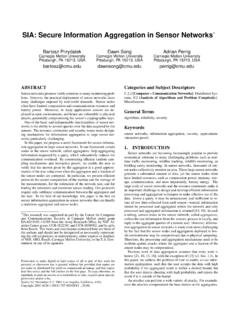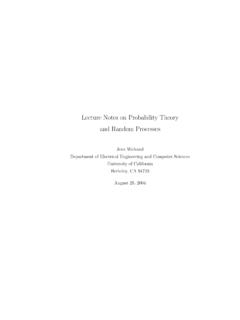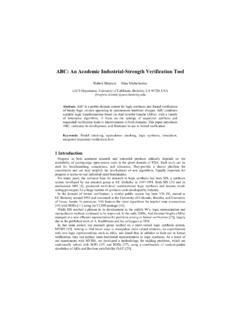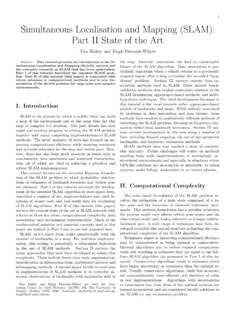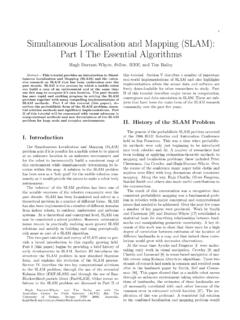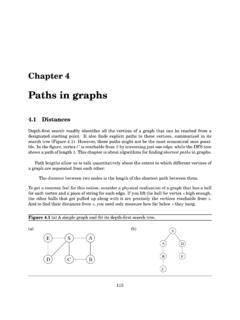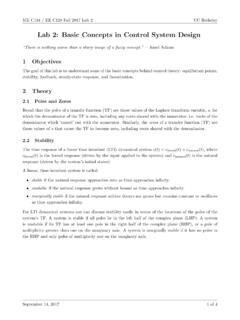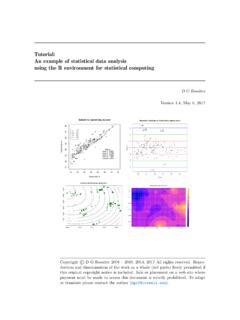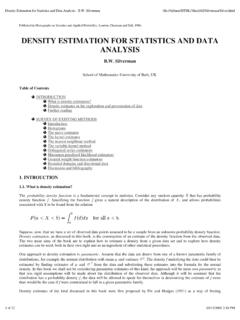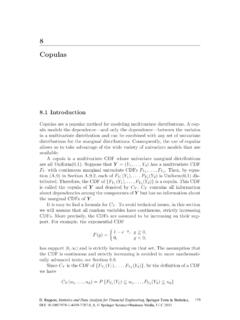Transcription of Graphical Models, Exponential Families, and Variational ...
1 Foundations and Trends R. in Machine Learning Vol. 1, Nos. 1 2 (2008) 1 305.. c 2008 M. J. Wainwright and M. I. Jordan DOI: Graphical Models, Exponential Families, and Variational Inference Martin J. Wainwright1 and Michael I. Jordan2. 1. Department of Statistics, and Department of Electrical Engineering and Computer Science, University of California, Berkeley 94720, USA, 2. Department of Statistics, and Department of Electrical Engineering and Computer Science, University of California, Berkeley 94720, USA, Abstract The formalism of probabilistic Graphical models provides a unifying framework for capturing complex dependencies among random variables, and building large-scale multivariate statistical models. Graphical models have become a focus of research in many statisti- cal, computational and mathematical elds, including bioinformatics, communication theory, statistical physics, combinatorial optimiza- tion, signal and image processing, information retrieval and statistical machine learning.
2 Many problems that arise in speci c instances . including the key problems of computing marginals and modes of probability distributions are best studied in the general setting. Working with Exponential family representations, and exploiting the conjugate duality between the cumulant function and the entropy for Exponential families, we develop general Variational representa- tions of the problems of computing likelihoods, marginal probabili- ties and most probable con gurations. We describe how a wide variety of algorithms among them sum-product, cluster Variational meth- ods, expectation-propagation, mean eld methods, max-product and linear programming relaxation, as well as conic programming relax- ations can all be understood in terms of exact or approximate forms of these Variational representations. The Variational approach provides a complementary alternative to Markov chain Monte Carlo as a general source of approximation methods for inference in large-scale statistical models.
3 1. Introduction Graphical models bring together graph theory and probability theory in a powerful formalism for multivariate statistical modeling. In vari- ous applied elds including bioinformatics, speech processing, image processing and control theory, statistical models have long been for- mulated in terms of graphs, and algorithms for computing basic statis- tical quantities such as likelihoods and score functions have often been expressed in terms of recursions operating on these graphs; examples include phylogenies, pedigrees, hidden Markov models, Markov random elds, and Kalman lters. These ideas can be understood, uni ed, and generalized within the formalism of Graphical models. Indeed, graphi- cal models provide a natural tool for formulating variations on these classical architectures, as well as for exploring entirely new families of statistical models.
4 Accordingly, in elds that involve the study of large numbers of interacting variables, Graphical models are increasingly in evidence. Graph theory plays an important role in many computationally ori- ented elds, including combinatorial optimization, statistical physics, and economics. Beyond its use as a language for formulating models, graph theory also plays a fundamental role in assessing computational 3. 4 Introduction complexity and feasibility. In particular, the running time of an algo- rithm or the magnitude of an error bound can often be characterized in terms of structural properties of a graph. This statement is also true in the context of Graphical models. Indeed, as we discuss, the com- putational complexity of a fundamental method known as the junction tree algorithm which generalizes many of the recursive algorithms on graphs cited above can be characterized in terms of a natural graph- theoretic measure of interaction among variables.
5 For suitably sparse graphs, the junction tree algorithm provides a systematic solution to the problem of computing likelihoods and other statistical quantities associated with a Graphical model. Unfortunately, many Graphical models of practical interest are not suitably sparse, so that the junction tree algorithm no longer provides a viable computational framework. One popular source of methods for attempting to cope with such cases is the Markov chain Monte Carlo (MCMC) framework, and indeed there is a signi cant literature on the application of MCMC methods to Graphical models [ , 28, 93, 202]. Our focus in this survey is rather di erent: we present an alternative computational methodology for statistical inference that is based on Variational methods. These techniques provide a general class of alter- natives to MCMC, and have applications outside of the Graphical model framework.
6 As we will see, however, they are particularly natural in their application to Graphical models, due to their relationships with the structural properties of graphs. The phrase Variational itself is an umbrella term that refers to var- ious mathematical tools for optimization-based formulations of prob- lems, as well as associated techniques for their solution. The general idea is to express a quantity of interest as the solution of an opti- mization problem. The optimization problem can then be relaxed . in various ways, either by approximating the function to be optimized or by approximating the set over which the optimization takes place. Such relaxations, in turn, provide a means of approximating the original quantity of interest. The roots of both MCMC methods and Variational methods lie in statistical physics.
7 Indeed, the successful deployment of MCMC. methods in statistical physics motivated and predated their entry into 5. statistics. However, the development of MCMC methodology specif- ically designed for statistical problems has played an important role in sparking widespread application of such methods in statistics [88]. A similar development in the case of Variational methodology would be of signi cant interest. In our view, the most promising avenue toward a Variational methodology tuned to statistics is to build on existing links between Variational analysis and the Exponential family of distri- butions [4, 11, 43, 74]. Indeed, the notions of convexity that lie at the heart of the statistical theory of the Exponential family have immediate implications for the design of Variational relaxations. Moreover, these Variational relaxations have particularly interesting algorithmic conse- quences in the setting of Graphical models, where they again lead to recursions on graphs.
8 Thus, we present a story with three interrelated themes. We begin in Section 2 with a discussion of Graphical models, providing both an overview of the general mathematical framework, and also presenting several speci c examples. All of these examples, as well as the majority of current applications of Graphical models, involve distributions in the Exponential family. Accordingly, Section 3 is devoted to a discussion of Exponential families, focusing on the mathematical links to convex analysis , and thus anticipating our development of Variational meth- ods. In particular, the principal object of interest in our exposition is a certain conjugate dual relation associated with Exponential fam- ilies. From this foundation of conjugate duality, we develop a gen- eral Variational representation for computing likelihoods and marginal probabilities in Exponential families.
9 Subsequent sections are devoted to the exploration of various instantiations of this Variational princi- ple, both in exact and approximate forms, which in turn yield various algorithms for computing exact and approximate marginal probabili- ties, respectively. In Section 4, we discuss the connection between the Bethe approximation and the sum-product algorithm, including both its exact form for trees and approximate form for graphs with cycles. We also develop the connections between Bethe-like approximations and other algorithms, including generalized sum-product, expectation- propagation and related moment-matching methods. In Section 5, we discuss the class of mean eld methods, which arise from a qualitatively 6 Introduction di erent approximation to the exact Variational principle, with the added bene t of generating lower bounds on the likelihood.
10 In Section 6, we discuss the role of Variational methods in parameter estimation, including both the fully observed and partially observed cases, as well as both frequentist and Bayesian settings. Both Bethe-type and mean eld methods are based on nonconvex optimization problems, which typically have multiple solutions. In contrast, Section 7 discusses vari- ational methods based on convex relaxations of the exact Variational principle, many of which are also guaranteed to yield upper bounds on the log likelihood. Section 8 is devoted to the problem of mode compu- tation, with particular emphasis on the case of discrete random vari- ables, in which context computing the mode requires solving an integer programming problem. We develop connections between (reweighted). max-product algorithms and hierarchies of linear programming relax- ations.
